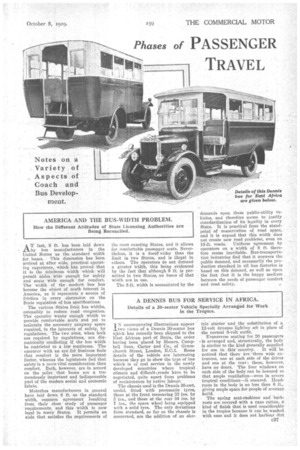' A DENNIS BUS FOR SERVICE IN AFRICA.
Page 75

Page 76

If you've noticed an error in this article please click here to report it so we can fix it.
Details of a 20-seater ,Vehicle Specially Arranged for Work in the Tropics.
JN accompanying illustrations appear two views of a Dennis 20-seater bus which has recently been shipped to the list African port of Beira, the order having been -placed by Messrs. Campbell Sons, Carter and Co., of Gracechurch Street, London, E.0.3. Some details of the vehicle are interesting because they go to show the type of bus which is of real service in the newly developed countries where tropical climate and difficult‘roads have to be negotiated, quite apart from problems of maintenance by native labour.
The chassis used is the Dennis 30-cwt model, fitted with pneumatic tyres, those at the front measuring 33 ins, by 15 ins., and those at the rear 34 ins. by 7 ins., the spare wheel being equipped with a solid tyre. The only deviations from standard, so far as the chassis is concerned, are the addition of an elec
trio starter and the substitution of a 12-volt dynamo lighting set in place of the normal 6-volt outfit.
Transverse seating for 20 passengers is arranged and, structurally, the body is similar to the kind generally supplied for use in this' country. It will be noticed that there are three wide entrances, one at each side of the driver and one at the rear ; these, however, have no doors. The four windows on each side of the body can be lowered so that ample ventilation—even in severe tropical conditions-1i ensured. Headroom in the body is no less than 6 ft., giving ample space for people of average build. '
The spring seat-cushions and backrests are covered with a cane rattan, a kind of finish that is used considerably in the tropics because it can be washed with ease and it does not harbour dirt or wear out quickly. Roller blinds are fitted to the windows and. as will be seen from the illustrations, the front bulkhead is fixed except for the quarterpanel of the windscreen before the driver, thi'S being adjustable. The rear Miff: merits of Weymaun construe tion are being increasingly realized, aud Weymann's Motor Bodies (1925), Ltd., of Addlestone, Surrey, has; during the past few months, received a considerable number of orders for motorbus and coach bodies. One of its recent commissions was for a special lightweight service-bus body, to be mounted upon . a Daimler CF6 forward-control chassis.
This body is extremely interesting, in that its weight is only 21 cwt., its construction following standard Weyminn practice, except that, in certain eases, the framework is grooved and that duraluntin is used in connection with some of the plates. Furthermore, a complete seat, designed to accommodate two passengers, weighs only 30 lb. In our issue dated June 4th we gave a brief description of the body, as, at the time of our visit to the Weymann works, it was in the initial stages of construction.
There is a door on the near side. behind the forward seat, whilst in the rear panel there is ,an emergency door. 'The driver's door is, of course, situated on the off side of his cab. The windows are made to crop, and are operated by Rawlings mechanism.
The seats are of the semi-bucket type, made up of strong hardwood frames; the backs arc carried on aluminium pressings, the seat frames being supported on steel legs. All the refinements to be found on modern long-distance coaches are incorporated in this vehicle.
During a recent .visit to the Weymann works we were able to examine two bodies that have been mounted on Maudslay doorway is provided with -two handrails of ample length and two permanently fixed steps. The interior is so arranged that there are no inaccessible corners which it would be difficult to keep clean, simplicity being the keynote, forward-control chassis, to the order of the Scottish Motor Traction Co., Ltd. A novel note in servicebus construction has been struck by
the employment of a full-width cab. The exterior is smartly finished in green, black and cream. A double-folding door is situated at the rear. The overall length of the vehicle is 27 ft. 6 ins., the overall width 7 ft. 6 ins., whilst the headroom is distinctly generous, this being 6 ft. 2 ins. This body is to be supplied without seats.
IVe also examined another vehicle, the basis of this being a Thernycroft orthodox-coutrol chassis. The body is designed to accommodate 26 passengers. There are three doors, two being situated on the near side. As in the case of the other vehicles, the interior . appointments follow normal practice, comfort being well studied.




























































































































